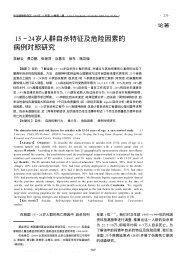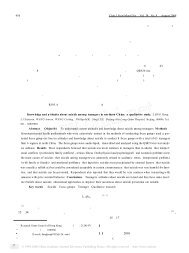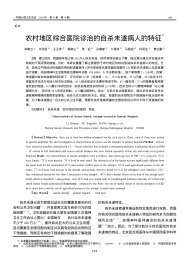Attitudes Toward Suicide Among Chinese People in Hong Kong
Attitudes Toward Suicide Among Chinese People in Hong Kong
Attitudes Toward Suicide Among Chinese People in Hong Kong
Create successful ePaper yourself
Turn your PDF publications into a flip-book with our unique Google optimized e-Paper software.
570 <strong>Attitudes</strong> <strong>Toward</strong> <strong>Suicide</strong> <strong>in</strong> <strong>Hong</strong> <strong>Kong</strong><br />
TABLE 2<br />
Cont<strong>in</strong>ued<br />
Overall (36.1% of variance, alpha = 0.852) Load<strong>in</strong>gs<br />
Factor 6 (Support: Support toward suicidal people) 3.3% of variance, alpha = 0.604<br />
69. Most people are will<strong>in</strong>g to offer psychological support to friends who want to attempt<br />
or commit suicide.<br />
70. Most people are will<strong>in</strong>g to offer material support to friends who want to attempt or<br />
0.579<br />
commit suicide. 0.576<br />
64. Most people care about those who had suicidal attempts. 0.558<br />
51. <strong>People</strong> can solve problems that may lead to suicide through personal effort.<br />
28. The suicide should have been able to change the psychological and personality factors<br />
0.405<br />
that led to suicide. 0.399<br />
66. Strengthen<strong>in</strong>g mental health services can reduce suicide. 0.365<br />
Factor 7 (Contagiousness: Contagiousness of suicide) 3.2% of variance, alpha = 0.511<br />
56. <strong>Suicide</strong> by celebrities leads to imitation by members of the general public. 0.605<br />
67. The media coverage of suicide news causes more people to attempt or complete suicide. 0.597<br />
71. Group suicide is becom<strong>in</strong>g more common <strong>in</strong> <strong>Hong</strong> <strong>Kong</strong>.<br />
3. <strong>Suicide</strong> leads to huge economic loss to society.0.441<br />
0.515<br />
Factor 8 (Sympathy: Sympathy towards suicide) 2.7% of variance, alpha = 0.334<br />
43. <strong>Suicide</strong> is not self-sought. 0.471<br />
22. Most people are sympathetic toward the person who had suicidal acts. 0.470<br />
63. <strong>Suicide</strong> is not under voluntary control. 0.412<br />
Factor 9 (Function: Function of suicide) 2.4% of variance, alpha = 0.308<br />
54. Sometimes a person may commit suicide for the welfare of another person.<br />
40. <strong>People</strong> with <strong>in</strong>terpersonal problems attempt or commit suicide primarily for the pur-<br />
0.460<br />
pose of mak<strong>in</strong>g threats or retaliat<strong>in</strong>g aga<strong>in</strong>st others. 0.498<br />
26. A person has the right to euthanasia as long as he/she chooses it. 0.352<br />
Note. 16 items that did not load on any factors were not listed.<br />
*Scored <strong>in</strong> reverse direction.<br />
tudes toward suicide among different socio- tudes toward suicide to a manageable number<br />
demographic groups of <strong>Ch<strong>in</strong>ese</strong> people <strong>in</strong> of perspectives, our respondents, like subjects<br />
<strong>Hong</strong> <strong>Kong</strong>. These f<strong>in</strong>d<strong>in</strong>gs are congruous <strong>in</strong> our focus groups, still exhibited several atwith<br />
<strong>Ch<strong>in</strong>ese</strong> historical sources that suggest titud<strong>in</strong>al dimensions that could be <strong>in</strong>tr<strong>in</strong>si-<br />
that there is no master theory that adequately cally contradictory. Thus, while four factors<br />
expla<strong>in</strong>s how <strong>Ch<strong>in</strong>ese</strong> people perceive sui- perta<strong>in</strong>ed to social and <strong>in</strong>terpersonal aspects<br />
cide. Rather, suicide might be endorsed and/ of suicide (suicidal spectrum, social change,<br />
or condemned by particular <strong>in</strong>dividuals un- contagiousness, and sympathy), the rema<strong>in</strong>der<br />
a variety of life situations. On the one <strong>in</strong>g five (negative appraisal, stigma, fatalism,<br />
hand, suicide can be a means of avoid<strong>in</strong>g un- support, and function) were about whether<br />
bearable situations as well as a partially sanc- suicide was right or wrong, or should be met<br />
tioned strategy for deal<strong>in</strong>g with a variety of with sympathy or disapproval. These mani-<br />
social, political, economic, and moral adver- festly dissimilar perspectives attest to the<br />
sities. On the other hand, suicide was to be moral complexity of suicide and cast doubt<br />
avoided and the dead person was <strong>in</strong> some on sweep<strong>in</strong>g statements about whether Chi-<br />
texts not to be mourned for (Hsieh & Spence, nese culture is for or aga<strong>in</strong>st suicide (L<strong>in</strong>,<br />
1981; Lee & Kle<strong>in</strong>man, 2005; L<strong>in</strong>, 1990; 1990).<br />
Wolf, 1975).<br />
Elderly suicide is one example of Chi-<br />
Although factor analysis reduces atti- nese people’s attitud<strong>in</strong>al complexity toward<br />
496
















